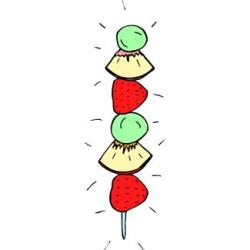Source Institutions
Source Institutions
Add to list Go to activity
Activity link broken? See if it's at the internet archive

In this math activity, learners use a variety of sensory modalities to gain experiences with identifying, describing and creating repeating patterns. Learners read and act out the book, "Brown Bear, Brown Bear What Do you See?" to explore word patterns in literature. They investigate musical sounds and rhythms by playing keyboards and water glass xylophones. Using tempera paints and sponge shapes, learners also create wrapping paper by repeating shape and color patterns. Even the sense of taste is used in pattern explorations as learners make fruit shish kabobs that have a definitive repeating pattern. Learners are also challenged to find patterns in nature as they examine a snake's skin and discuss patterns in other animals. These activities can be set up as centers or facilitated individually.
- 30 to 45 minutes
- 1 to 2 hours
- Over $20 per group of students
- Ages 4 - 6
- Activity, Lesson/Lesson Plan
- English
Quick Guide
Materials List (per group of students)
- "Brown Bear, Brown Bear, What Do You See" by Bill Martin Jr.
- Large masks for main characters in book (Brown Bear, Red Bird, Yellow Duck, Blue Horse, Green Frog, Black Sheep, Purple Cat, Goldfish, White Dog, Mother)
- Chart with common word endings or word families - at - it - ack - ick, etc.
- White unlined paper
- Pencils
- A variety of sponge shapes (hearts, stars, circles, dinosaurs, etc.)
- Tempera paints (3-5 colors)
- Large sheets of white unlined paper, approximately 36 inches x 20 inches
- Unlined paper, approximately 12 inches by 5 inches
- 12 water glasses with various amounts of water (food coloring may be added to color the water)
- Xylophone mallet
- Labels for water glasses
- Keyboards
- Bowls of pieces of fruit and marshmallows
- Shish kabob skewers with blunt ends
- 24-36 plastic eggs of different colors
- 6 ice cube trays
- Charts showing pictures of birds, butterflies, snakes, etc.
- Yarn pieces about 18 inches in length
- A variety of beads, pieces of straws, uncooked pasta
- Collection of books with repeating phrases ("Polar Bear, Polar Bear," "Three Billy Goats Gruff," "The Three Little Pigs," "The Very Busy Spider")
Subjects
-
Life Sciences
-
Diversity of Life
- Animals
-
Diversity of Life
-
Mathematics
-
Algebra
- Patterns
-
Geometry
- Plane Geometry
-
Algebra
Informal Categories
- Animals
- Arts and Crafts
- Food and Cooking
- Literature
- Music
- Nature and Environment
Audience
To use this activity, learners need to:
- see
- see color
- read
- hear
- touch
Learning styles supported:
- Links STEM to other topics of interest such as arts and humanities
- Involves hands-on or lab activities
Other
This resource is part of:
Access Rights:
- Free access
By:
Rights:
- All rights reserved, PBS, 2012
Funding Source:
- US Department of Education
